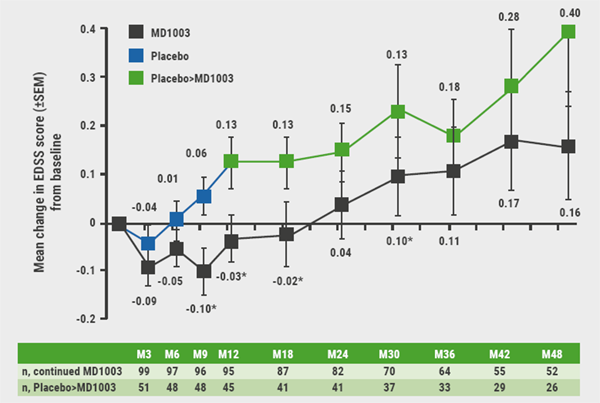Detection of MS in the early stages is complicated due to the absence of above-threshold symptoms. Sub-threshold MS lesions are compensated by functional reserve and yield no physical deficits. The threshold above which clinical deficits are recognised depends on the sensitivity of the assessment techniques. The widely used EDSS defines a score of 0 as ‘neurologically normal.’
“We are only as sensitive as our tests allow,” Dr Stephen Krieger (Mount Sinai Hospital, NY, USA) explained. “The recent concept of silent progression has been highly discussed. But it is only silent if we are not listening.” Recognition of sub-threshold deficits in apparently neurologically normal MS patients may help to better understand and predict the disease course. Dr Krieger and his colleagues hypothesised that higher-challenge tasks may be more sensitive to sub-threshold deficits, with neuroimaging correlates. “Patients with an EDSS score of 0 should be the same as healthy controls, but are they?”
To answer this question, 63 recently (<5 years) diagnosed MS patients in the RADIEMS cohort with an EDSS of 0 were compared with 50 matched healthy controls on standard tasks, including the timed 25-foot walk (T25FW) and high-challenge measures of upper extremity coordination (9-Hole Peg, Grooved Pegboard) and balance (NIH Toolbox Balance, Balance Boards).
Results showed that patients with an EDSS score of 0 also had normal T25FWs (median 3.95; interquartile range 3.75–4.24). However, patients performed worse than controls on:
- upper extremity (P=0.039);
- balance (P=0.005);
- overall function (P=0.006).
The higher overall function was associated with lower T2 lesion volume (T2LV; r=-0.344; P=0.006) and higher normalised thalamic volume (nThal; r=0.461; P<0.001). Dr Krieger concluded: “These results show that EDSS 0 is not normal. This challenges the existing dogma of how we define MS severity right from the beginning.” He added that correlations between challenge task performance and imaging markers (T2LV and nThal) encapsulate both lesional burden of MS and a volumetric measure of brain reserve.
- Krieger S, Sumowski J. Subclinical burden of multiple sclerosis at EDSS 0. OP122, ECTRIMS 2021 Virtual Congress, 13–15 October.
Copyright ©2021 Medicom Medical Publishers
Posted on
Previous Article
« Personality trait alterations in MS patients Next Article
Melatonin associated with improved sleep quality in MS patients »
« Personality trait alterations in MS patients Next Article
Melatonin associated with improved sleep quality in MS patients »
Table of Contents: ECTRIMS 2021
Featured articles
Preliminary data shows positive results of ATA188 for progressive MS
COVID-19
MS patients at risk of hampered immune response after vaccination
Immunotherapy in MS does not influence COVID-19 severity and mortality
Anti-CD20 antibodies associated with worse COVID-19 outcomes
ECTRIMS-EAN consensus on vaccination in MS patients
Experimental Treatments
The role of astrocyte phenotypes in acute MS lesions
Promising results of intrathecal MSC-NTF cells in progressive MS
Preliminary data shows positive results of ATA188 for progressive MS
Evobrutinib reduces relapses and MRI lesion activity
Primary endpoint of opicinumab for relapsing MS not met in AFFINITY trial
Elezanumab did not outperform placebo in progressive and relapsing MS
Ibudilast reduced retinal atrophy in primary progressive MS
Treatment Trials and Strategies
ECTRIMS/EAN Clinical Guidelines on MS treatment: an update
Rituximab most effective initial MS therapy in Swedish real-world study
Ublituximab meets primary endpoint for relapsing MS
Dynamic scoring system aids decision to switch MS therapies early
Long-term suppression of MRI disease activity with ocrelizumab
Stopping DMT: when or if at all?
Biomarkers
Early predictors of disability progression in paediatric-onset MS
High-sensitive biomarker detection in MS via novel ELISA assay
Cortical lesions predict cognitive impairment 20 years after MS diagnosis
Applicability of sNfL measurement in clinical practice
MRI more sensitive for disease activity than relapses in SPMS
Imaging
Changes in GABA-receptor binding among cognitively impaired MS patients
T2 lesions independently predict early conversion to SPMS
Natural killer-like CD8+ T cells as a reservoir of clonal cells related to MS activity
Neuromyelitis Optica Spectrum Disorder (NMOSD)
Eculizumab, satralizumab, or inebilizumab for NMOSD?
Long-term efficacy of satralizumab for NMOSD
Long-term efficacy data: inebilizumab for NMOSD
Progressive MS
Charcot Award 2021: Progressive MS, a personal perspective
Top score poster: Meta-analysis on the effect of DMTs
Cortical lesions predict disease progression and disability accumulation
Ocrelizumab shows long-term benefits in primary progressive MS
Other
WNT9B-gene variant associated with doubled relapse risk in MS
Melatonin associated with improved sleep quality in MS patients
“Expanded Disability Status Scale 0 is not normal”
Personality trait alterations in MS patients
Related Articles
November 8, 2019
Sustained reduction in disability progression with ocrelizumab
July 25, 2024
How different are late onset and adult onset MS really?

July 30, 2019
Biotin, ocrelizumab, and ibudilast in progressive MS
© 2024 Medicom Medical Publishers. All rights reserved. Terms and Conditions | Privacy Policy
HEAD OFFICE
Laarderhoogtweg 25
1101 EB Amsterdam
The Netherlands
T: +31 85 4012 560
E: publishers@medicom-publishers.com

